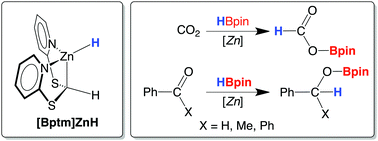Synthesis of bis(2-pyridylthio)methyl zinc hydride and catalytic hydrosilylation and hydroboration of CO2†
Abstract
The reactions of bis(2-pyridylthio)methane with Me2Zn and Zn[N(SiMe3)2]2 afford [Bptm]ZnMe and [Bptm]ZnN(SiMe3)2, thereby providing access to a variety of other [Bptm]ZnX derivatives, including the zinc hydride complex [Bptm]ZnH, which serves as a catalyst for the reduction of CO2 and other carbonyl compounds via hydrosilylation and hydroboration.

- This article is part of the themed collection: Boron Chemistry in the 21st Century: From Synthetic Curiosities to Functional Molecules


 Please wait while we load your content...
Please wait while we load your content...